All Central Bank Balance Sheets Are Exploding Higher, Or Engaged In QE
The degree to which central banks around the world are printing money is unprecedented.
The first eight charts below show the balance sheets of the largest central banks in the world. They are the European Central Bank (ECB), the Federal Reserve (Fed), the Bank of Japan (BoJ), the Bank of England (BoE), the Bundesbank (Germany), the Banque de France, the People's Bank of China (PBoC) and the Swiss National Bank (SNB). Noted on the charts are significant events or growth rates.
Shown is the size of each respective balance sheet in its local currency. Note that all are exploding higher as every chart goes from the lower left to the upper right. Most are still making new all-time highs. If the basic definition of quantitative easing (QE) is a significant increase in a central bank's balance sheet via increasing banking reserves, then all eight of these central banks are engaged in QE.
>
Click to enlarge:

˜˜˜
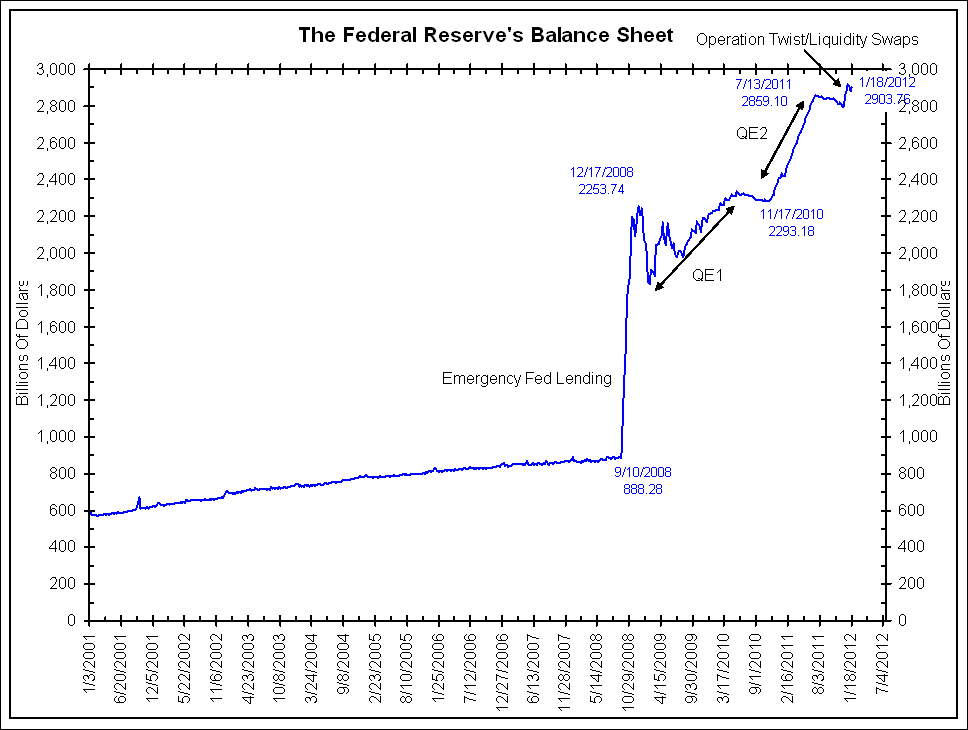
˜˜˜

˜˜˜

˜˜˜

˜˜˜
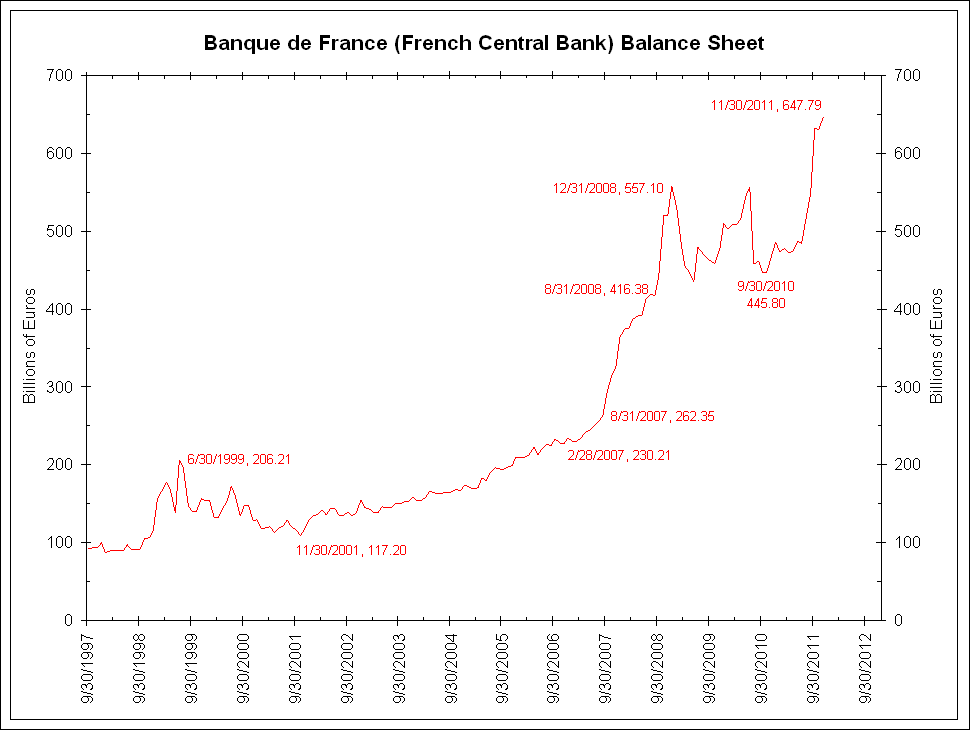
˜˜˜
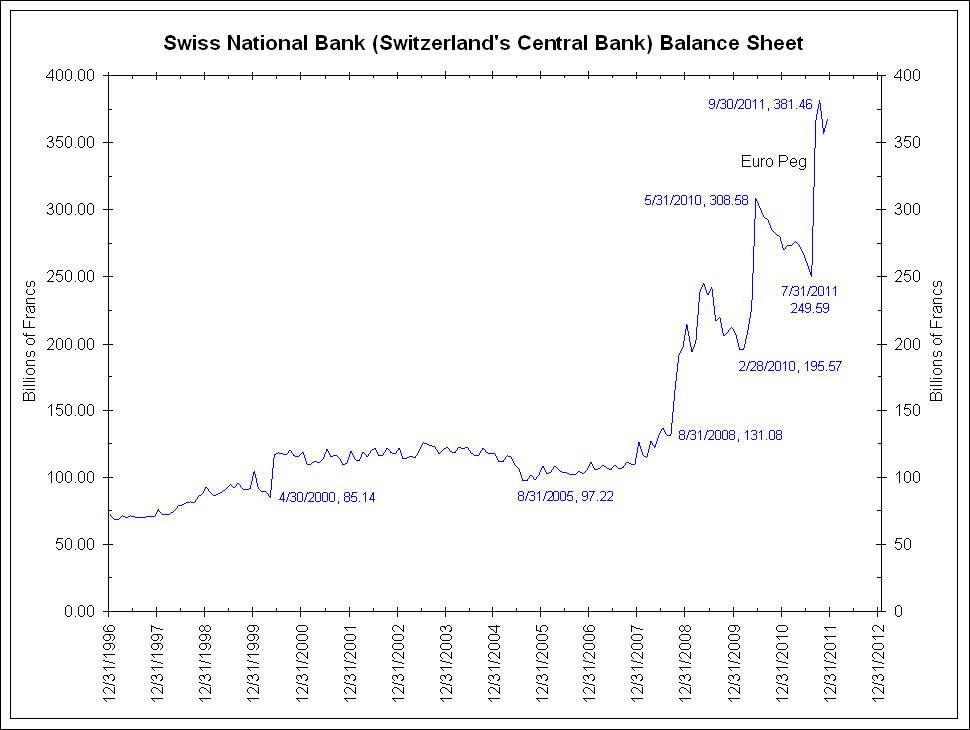
>
Comparing Central Bank Balance Sheets
For comparison's sake, we converted the eight balance sheets above into dollar terms. The four largest, the PBoC, the Fed, the BoJ and the ECB are shown in the first chart below. The second four, the Bundesbank, Banque de France, the BoE and SNB are shown in the second chart below. We split them up because of their vastly different scales.
In the first chart, note that the balance sheets of the PBoC and the ECB are larger than the Federal Reserve when converted to dollars. The BoJ used to be the largest balance sheet in dollar terms until 2006.
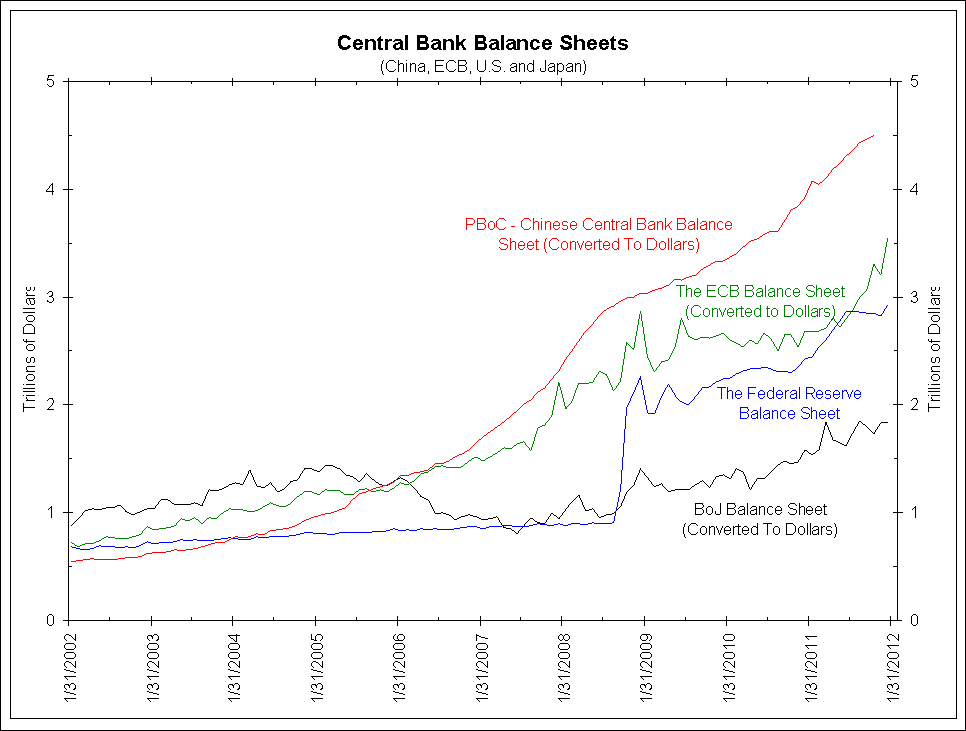
When shown in dollar terms below, the Bundesbank is the largest of the "second four" central banks. Further, its growth rate over the last five years has been among the highest. This is surprising since the Bundesbank is considered the "hard money" central bank.

Combining Central Bank Balance Sheets
The next chart below adds up the eight largest central bank balance sheets in dollar terms. It is only current through October as that is the latest number from the PBoC.
The combined size of these eight central banks' balance sheets has almost tripled in the last six years from $5.42 trillion to more than $15 trillion and is still on the rise!
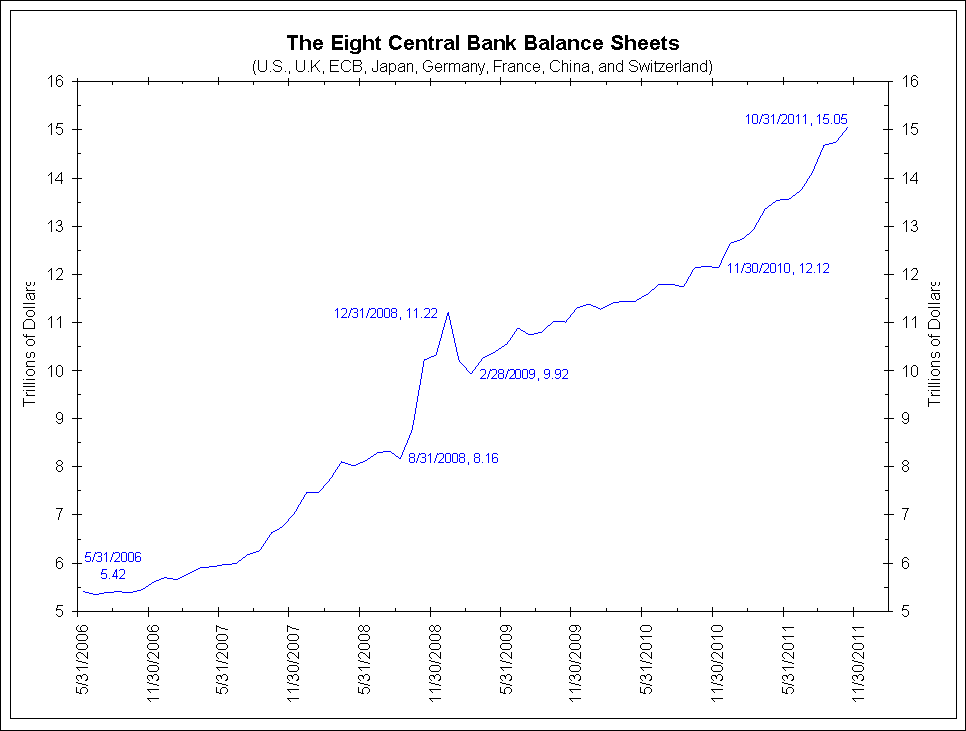
Central Banks Equal To One-Third Of World Equity Values
As noted above, QE is an expanding of balance sheets via increasing bank reserves. The purpose of QE, as explained by this Bank of England video, is to increase bank reserves through purchases of fixed income securities in order to lower interest rates. This makes fixed income securities relatively unattractive/overvalued and pushes investors out the risk curve. This should increase buying for riskier assets such as stocks, pushing them higher in price. Theoretically these higher prices should lead to a wealth effect and increased economic activity.
Given this definition and purpose, it is fair to compare the size of these balance sheets (now $15 trillion) to the capitalization of the world's stock markets (now $48 trillion). This is shown in the chart below.
Prior to the 2008 financial crisis, the eight central bank balance sheets were less than 15% the size of world stock markets and falling. In the immediate aftermath of Lehman Brothers' failure, these eight central bank balance sheets swelled to 37% the capitalization of the world stock market. But keep in mind that the late 2008/early 2009 peak was due to collapsing stock market values combined with balance sheet expansion via "lender of last resort" loans.
Recently, the eight central bank balance sheets have spiked back to 33% of world stock market capitalization. This has come about not by lender of last resort loans, but rather by QE expansion (buying bonds with "printed money") even faster than world stock markets are rising.
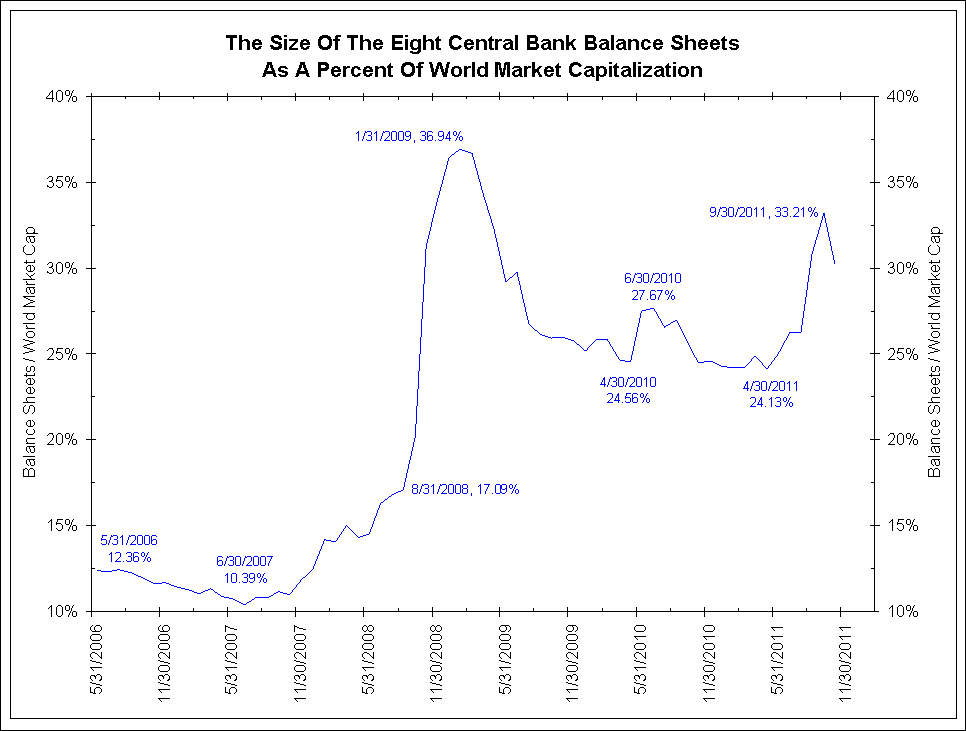
What Does It All Mean?
In our conference call earlier this month we said (page 12):
2011 was so difficult because all stocks seemingly moved together. It was as if every S&P 500 company had the same chairman of the board that knew only one strategy, resulting in a high degree of correlation between seemingly unrelated companies.
Massive central bank involvement in the markets risks returning us to a de facto centrally planned economy. Those S&P 500 companies all have the same chairman; it is Ben Bernanke because his policies are affecting everybody. That is what makes money management so difficult. Correlations will ebb and flow; they always do. But what makes them go away? This will only happen when governments and central banks go away.
But if they go away, then does that not mean things get ugly? Maybe they do get ugly, but it also means that we sort out the excesses in the market. We reward the people that do the right thing and we punish the people that do the wrong thing. And we have an adjustment process that may be ugly, but then we have a period of long expansion.
Central banks are ruling markets to a degree this generation has not seen. Collectively they are printing money to a degree never seen in human history.
So how does this process get reversed? How do central banks pull back trillions of dollars of money printing without throwing markets into a tailspin? Frankly, no one knows, least of all central banks as they continue to make new money printing records.
Until a worldwide exit strategy can be articulated and understood, risk markets will rise and fall based on the perceptions and realities of central bank balance sheets. As long as this is perceived to be a good thing, like perpetually rising home prices were perceived to be a good thing, risk markets will rise.
When/If these central banks go too far, as was eventually the case with home prices, expanding balance sheets will no longer be looked upon in a positive light. Instead they will be viewed in the same light as CDOs backed by sub-prime mortgages were when home prices were falling. The heads of these central banks will no longer be put on a pedestal but looked upon as eight Alan Greenspans that caused a financial crisis.
The tipping point between balance sheet expansion being bullish for risk assets versus bearish is impossible to know. Given the growth rate of central bank balance sheets around the world over the past few years, we might not have to wait too long to find out. Enjoy it while it is still bullish.
Iran has agreed to be paid 45 percent of revenue from its Indian oil exports in rupees, to be deposited with an Indian bank beyond the reach of new US and European sanctions, a report said Thursday.
The two countries have chosen UCO Bank, headquartered in the eastern city of Kolkata, for the rupee transactions to settle part ofIndia's $12.68-billion annual oil bill, The Indian Express reported.
India currently pays for 20 percent of its oil imports from Iran in rupees, with the remainder settled in euros at the Turkish bank, Turkiye Halk Bankasi.
There are concerns that the Turkish route will be closed by tough new European sanctions on oil exports from Iran imposed over the Islamic Republic's disputed nuclear programme.
India has said it will continue to buy crude from Iran despite moves by the US and Europe to further isolate the country, which accounts for 12 percent of India's annual oil imports.
ITC may hike stake upto 25% in EIH & Hotel Leela: Deveshwar
Published on Fri, Jan 27, 2012 at 13:15 | Source : CNBC-TV18
ITC chairman YC Deveshwar has said that his company may increase stake in the Oberois controlled- EIH and Krishnan Nair-owned Hotel Leela , if the prices are attractive.
In the same breath, he added that it was for the treasury division to take a call on that. Speaking to CNBC-TV18, Deveshwar said the company's investments in EIH and Hotel Leela were purely treasury decisions. "We are a buyer and seller in EIH, Hotel Leela at the right price," Deveshwar told CNBC-TV18.
Under the new Sebi takeover code, an acquirer can buy up to 25% in a target company without having to make an open offer.
Earlier, the threshold limit beyond which the acquirer had to compulsorily make an open offer was 15%. ITC holds 14.98% in EIH, and a little over 13% in Hotel Leela, as on December 31, 2011.
ITC started buying EIH shares in 2001, and built its stake in Hotel Leela over the last three years. While Deveshwar may deny any plans of taking control of the two firms, the market is skeptical if ITC will be content to remain a passive investor in these companies for long.
More so, in the light of the latest statement by Deveshwar, who expects also shares of hotel companies to underperform near term because of poor earnings arising from a sluggish global economy. On Wednesday, Indian Hotels reported a tepid 7.4% year-on-year growth in quarterly revenues, despite the quarter being the best for the hospitality sector in general.
In August 2010, RIL picked up a 14.2% stake in EIH, ostensibly to help the Oberois pre-empt a hostile bid by ITC. Market watchers are keenly watching if ITC would want to challenge the Ambanis by increasing their stake in EIH to the maximum permissible 25%.
SEBI CURBING LISTING DAY Volatility:
For new IPO or Re listing there will be 60 minutes pre market call
session (9-10am) - No circuit limit in Pre Open. Post 10am script will
open at discovery price.
There will be Circuit limit post open
For IPOs greater thn 250cr circuit - 20% and for IPOs less than 250cr
circuit will be 5%. Script will trade in T2T for 10 trading sessions.
session (9-10am) - No circuit limit in Pre Open. Post 10am script will
open at discovery price.
There will be Circuit limit post open
For IPOs greater thn 250cr circuit - 20% and for IPOs less than 250cr
circuit will be 5%. Script will trade in T2T for 10 trading sessions.
Natural gas prices have hit a 10-year low thanks in part to a mild winter throughout much of North America — and that's good news for many consumers, observers say.
The price of natural gas — which consumers use largely to heat their homes — fell 6.8 per cent to US$2.49 on the New York Mercantile Exchange on Tuesday.
"As a general rule, when the commodity prices are lower, utility bills trend down over time," said Timothy Egan, president and chief executive officer of the Canadian Gas Association.
"It's not going to vary month to month. The utilities are revisiting this according to formulas that they've got in place with regulators."
Forecasters see above-average temperatures persisting for the next few weeks in many parts of North America, and U.S. supplies of natural gas remain well above their five-year average.
In the short-term, the lower demand affects natural gas prices, but there are long-term factors pushing down the price over time, too, said Egan.
One of those is the plentiful supply gushing out of shale rock formations throughout North America, thanks to advances in drilling technology.
"There's more supply in the market now than we've had in an extremely long time because of more and more gas finds, particularly unconventional gas. It's changed the supply picture dramatically in North America," he said.
Egan said he doesn't see any nasty surprises looming ahead for consumers.
"Supplies are very robust. Storage facilities are full in anticipation of the winter. So we're not anticipating any sudden spikes of any kind. We're expecting it to be a more-than-manageable winter from a consumer perspective," he said.
Bill Gwozd, vice-president of gas services at Ziff Energy Services in Calgary, agrees lower gas prices are "excellent" for consumers.
"However, some of them may have locked in to higher rates. They may have locked into rates last year and they thought maybe that was the low."
While temperatures in Western Canada have been plunging, Gwozd says the population is too small there to affect prices much. But a prolonged cold snap in big cities like New York or Chicago would move the needle.
For natural gas producers seeking a reprieve from the low prices, Gwozd said "you want to offer prayer services for cold weather in populated regions that are large gas consumers."
Aside from that, one of the only things natural gas companies like Encana Corp. (TSX:ECA) can control are their operating costs.
"That producer that becomes the lowest cost producer can survive in this environment. The high-cost producer's going to get wiped out," he said.
Long-term, Gwozd sees natural gas prices strengthening as volumes are exported from the West Coast in liquid form or converted in to transportation fuels — what he calls "unconventional demand."
Message addressed to U.S-backed Gulf Arab oil exporters
* France sees EU imposing oil sanctions on Iran on Monday
* Turkey works to cut dependence on Iranian oil-sources
Iran's foreign minister warned neighbouring states not to put themselves in a "dangerous position" by aligning themselves too closely with the United States in the escalating dispute over Tehran's nuclear activity.
Confrontation is brewing over Tehran's nuclear work, which Washington and other powers say is focused on developing atomic weapons. Irandismisses the accusation.
Iran has threatened to close the Strait of Hormuz, used for a third of the world's seaborne oil trade, if pending Western moves to ban Iranian crude exports cripple its lifeblood energy sector, fanning fears of a slide into wider Middle East war.
European Union foreign ministers are expected at a meeting on Monday to agree an oil embargo against Iran and a freeze on the assets of its central bank, French Foreign Minister Alain Juppe said, confirming diplomatic leaks.
Saudi Arabia, the world's No. 1 oil exporter, riled Iran earlier this week when it said it could swiftly raise oil output for key customers if needed, a scenario that could transpire if Iranian exports were embargoed.
Industry sources told Reuters on Thursday Turkish refiner Tupras also planned to cut its dependence on imports of Iranian oil, partly in response to the Hormuz threat.
"We want peace and tranquility in the region. But some of the countries in our region, they want to direct other countries 12,000 miles away from this region," Iranian Foreign Minister Ali Akbar Salehi said in English during a visit to Turkey on Thursday, before the news emerged about Tupras.
The remark was an apparent reference to the alliance of Iran's Arab neighbours with Washington, which maintains a big naval force in the Gulf and says it will keep the waterway open.
"I am calling to all countries in the region, please don't let yourselves be dragged into a dangerous position," Salehi told Turkey's NTV broadcaster.
He added the United States should make clear that it was open for negotiations with Tehran without conditions. He referred to a letter Iran says it received from U.S. President Barack Obama about the situation in the Straight of Hormuz, the contents of which have not been made public.
The White House has refused to comment on the letter.
"Mr Obama sent a letter to Iranian officials, but America has to make clear that it has good intentions and should express that it's ready for talks without conditions," he said.
"Out in the open they show their muscles but behind the curtains they plead to us to sit down and talk. America has to pursue a safe and honest strategy so we can get the notion that America this time is serious and ready."
The United States, like other Western countries, says it is prepared to talk to Iran but only if Tehran agrees to discuss halting its enrichment of uranium. Western officials say Iran has been asking for talks "without conditions" as a stalling tactic while refusing to put its nuclear programme on the table.
IAEA CHIEF SAYS MUST ALERT WORLD ABOUT IRAN
The International Atomic Energy Agency chief said it was his duty to alert the world about possible military aspects to Iran's nuclear campaign, keeping the heat on Tehran ahead of a rare visit by senior IAEA officials for talks on Jan. 29-31.
"What we know suggests the development of nuclear weapons," the head of the U.N. agency was quoted as saying by Financial Times Deutschland on Thursday. "We want to check over everything that could have a military dimension."
An IAEA delegation, to be headed by Deputy Director General Herman Nackaerts, is expected to seek explanations for intelligence information indicating Iran has engaged in research and development applicable to nuclear weapons.
Tehran says it is refining uranium only for electricity generation and medical applications.
Salehi said on Wednesday that Iran, the world's fifth biggest oil exporter, was in touch with world powers to reopen talks that he expected to be held soon.
Washington and the EU quickly denied this, saying they are still waiting for Iran to show it wanted serious negotiations addressing fears that it trying to build atom bombs.
Turkish Foreign Minister Ahmet Davutoglu said after meeting Salehi that all sides were willing to resume talks but the time and place need to be settled. "I will tell Ms. Ashton about the talks today," he told reporters, referring to the EU foreign policy chief who represents world powers trying to engage with Iran.
"We have always said we are ready for dialogue," France's Juppe told reporters in Paris. "Ashton has made concrete offers, but sadly until today Iran has not committed transparently or cooperatively to this discussion process."
He added: "It's for this reason that to avoid an irreparable military option we have to strengthen sanctions."
STAGE SET FOR SANCTIONS
The stage was set for international oil sanctions against Iran when Obama signed legislation on Dec. 31 that would freeze out any institution dealing with Iran's central bank, making it impossible for most countries to buy Iranian crude.
Diplomats said the EU's 27 member states were still mulling details such as when an embargo would start. They were looking into a grace period that would end in July to help some debt-ridden EU states that rely on Iranian oil to adjust to a ban.
"On the central bank, things have been moving in the right direction," an EU diplomat said. "There is now wide agreement on the principle. Discussions continue on the details."
Turkey, which imports more than 30 percent of its daily consumption from Iran, has so far given no indication that it will comply with the planned EU embargo.
But an industry source said that Iranian threats to shut down the Strait of Hormuz had helped push Turkish oil officials to try to reduce the country's heavy dependence on Iran's oil.
Another of the sources said Tupras officials were planning to meet Saudi Arabian oil authorities this month, with a view to switching to alternative sources of crude by the summer.
Tupras declined to give an immediate comment.
Japanese Trade Minister Yukio Edano said on Friday he told visiting U.S. officials that Japan's imports of Iranian crude had fallen 40 percent in the past five years, and the trend will continue.
BUY NEYVELI LIGNITE CORPORATION LIMITED (513683)
CMP: 90
Target: 150 in 6 months
NLC is a government-owned lignite mining Indian company, which is wholly owned by the Union Government (49%) and administered via coal ministry. It is recently announced as "Navratna" by Government of India in April 2011. NLC Neyveli spreads over an area of around 54 square km, comprising Neyveli Township and temporary colonies around 32 blocks. The company runs the biggest open-pit lignite mines in India and mines around 2.4 Croretonnes of lignite annually for fuel, with an installed capacity of 2490 MW of electricity per annum.
NLC now elaborated its project to Rajasthan also in mining as well as thermal stations, 3 big mines also supplies a huge amount of sweet water to Chennai. The Tamil Nadu electricity board has a JV with the Neyveli Lignite Corporation Ltd (NLC) for two projects – A 1000-MW coal-based project at Tuticorin in southy Tamil Nadu at the cost of Rs.4000 crore and the Jayamkondam lignite power project at a cost of Rs.5000 crore for 1000 – MW power plant. The company announced its plans to invest about Rs.36,900crore on power generation and mining capacity augmentation by 2017. The company has also planned to develop clean coal technologies like extraction of coal bed methane (CBM) and Underground coal gasification for which several steps have been taken. It is developing power projects using other fuel feed. The company is also planning to invest Rs.40,200crore to build power plants in Tamil Nadu, Rajasthan and Uttar Pradesh.
The coal price has risen by 50% due to which Tamil Nadu Govt has increased Electricity Power tariff by 30%, and imported coal also raised upto 60% due to Rupee devaluation which will directly benefit NLC for ownership of their mines.
Strong expansion & diversification plans to explore coal-based, wind and solar power generation projects will add on strength to the cashbook.
We recommend `BUY' on the stock at CMP Rs. 90 with a target price of Rs. 150 in 6 months
A lengthy article, "Will Israel Attack Iran," published in this week's New York Times magazine confirms that Israel has made advanced preparations for military strikes on Iran. The author—Ronen Bergman, a well-connected political analyst with the Israeli newspaper Yedioth Ahronoth—concluded: "After speaking to many senior Israeli leaders and chiefs of the military and the intelligence, I have come to believe that Israel will indeed strike Iran in 2012."
Bergman corroborated previous articles in the Israeli press reporting that Prime Minister Benjamin Netanyahu and Defence Minister Ehud Barak have been pressing for the country's security cabinet to authorise an attack on Israel. Vice Prime Minister Moshe Ya'alon told Bergman last week: "It is a matter of months before the Iranians will be able to attain military nuclear capability… We are prepared to defend ourselves in any way and anywhere that we see fit."
Claims that Iran is on the point of constructing a nuclear weapon are not supported by facts. The latest International Atomic Energy Agency (IAEA) report—a political document designed to justify the latest US and European sanctions against Iran's oil exports—provided limited evidence of Iranian research related to aspects of building a nuclear bomb. Much of the "evidence" came from US, European and Israeli intelligence sources. Most of the research projects were discontinued after 2003. Iran continues to deny any plans to build nuclear weapons.
Highlighting the bogus character of Israeli claims, veteran journalist Robert Fisk commented in the Independent: "The Israeli President [Peres] warns us that Iran is on the cusp of producing a nuclear weapon… Yet we reporters do not mention that Shimon Peres, as Israeli Prime Minister, said exactly the same thing in 1996… And we do not recall that the current Israeli PM, Benjamin Netanyahu, said in 1992 that Iran would have a nuclear bomb by 1999."
The prominence given to the New York Times article suggests that Bergman is the conduit for a message from the Israeli establishment to pressure the Obama administration and more broadly the US ruling elites to take more aggressive action against Iran. The US and European Union have effectively imposed an embargo on Iranian oil exports, as well as the country's central bank, to operate fully from July.
In a barrage of comments, senior Israeli figures this week called for tougher measures. Defence Minister Barack demanded "very strong and quick pressure on Iran," repeating the lie that Iran was producing "nuclear weapons without hindrance." Finance Minister Yuval Steinitz questioned whether the US/EU embargo was sufficient and called for "a massive blockade" of Iran by sea and air—itself an act of war under international law. Yesterday, former Israel Defence Force (IDF) chief Gabi Ashkenazi stressed that Israel had to "keep a reliable [military] option on the table with the willingness to use it if necessary."
In Tuesday's State of the Union speech, President Barack Obama boasted that his administration had ensured that Iran was "more isolated than ever before" and "faced with crippling sanctions." He pointedly warned: "Let there be no doubt: America is determined to prevent Iran from getting a nuclear weapon, and I will take no options off the table to achieve that goal." In other words, the US is prepared to launch war against Iran on the pretext of halting its nuclear programs.
Bergman's article underlined the close collaboration between the US and Israel, and pointed to the likely timetable for an attack on Iran. Barak told the journalist that "no more than a year remains to stop Iran from obtaining nuclear weaponry." A senior Israeli security source declared: "The Americans tell us there is time, and we tell them that they only have about six to nine months more than we do, and that therefore the sanctions have to be brought to a culmination now, in order to exhaust that track.
Bergman explained that the Israeli military, particularly since Barak became defence minister, "has prepared in unprecedented ways for a strike against Iran." The Israeli Air Force "maintains planes with the long-range capacity required to deliver ordnance to targets in Iran, as well as unmanned aircraft capable of carrying bombs to those targets and remaining airborne for up to 48 hours." The IDF had also prepared plans to deal with any Iranian retaliation.
The article detailed the criminal covert war of assassination and sabotage waged by the Israeli intelligence agency Mossad inside Iran since 2004. Under Prime Minister Ariel Sharon, Mossad was given "virtually unlimited funds and powers" for a "five-front strategy," involving "political pressure, covert measures, proliferation, sanctions and regime change." Mossad chief Meir Dagan sent a secret cable to Washington in August 2007 stressing that "the United States, Israel and like-minded countries must push on all five fronts in a simultaneous joint effort."
The gangster-like operations of Mossad, acting with the complicity or involvement of the US, included financial sabotage, computer viruses, the sale of faulty parts and raw materials, unexplained plane crashes, explosions at Iranian facilities, and the murder of Iranian scientists, most recently of Massoud Ali Mohammadi on January 11. The article indicated that Mossad had financed, armed and trained two groups—the Muhjahedin Khalq (MEK) and the Sunni extremist outfit Jundallah—to carry out the assassinations.
The barely disguised gloating over these crimes, in Bergman's article and by Israeli leaders and officials, points to their real purpose—to goad Iran into retaliation that could provide for the further media demonisation of the regime and the pretext for war. This thuggery underlines the fact that the greatest danger of war in the Middle East stems from Israel, which has an estimated arsenal of 300 nuclear weapons and has repeatedly resorted to wars of aggression to maintain its dominance, and its backers in Washington, which has already invaded Afghanistan, then Iraq and is now menacing Iran.
While publicly the Obama administration has focussed on the "crippling sanctions" on Iran, it is also carrying out preparations for military action—a subject openly debated in US newspapers and journals. The Pentagon this month doubled the number of aircraft carrier battle groups near the Persian Gulf and thus its capacity to wage an air and sea war against Iran.
Washington's allies in Europe are getting ready for war as well. French and British warships accompanied the aircraft carrier, the USS Abraham Lincoln, into the Gulf last Sunday. British Defence Secretary Philip Hammond declared on Monday: "The UK has a contingent capability to reinforce its presence in the region should at any time it be considered necessary to do so."
By recklessly escalating the economic embargo and military threats against Iran, the US, Israel and the European powers are heightening the danger of a slide into war that has the potential to engulf the region and to spread internationally.



